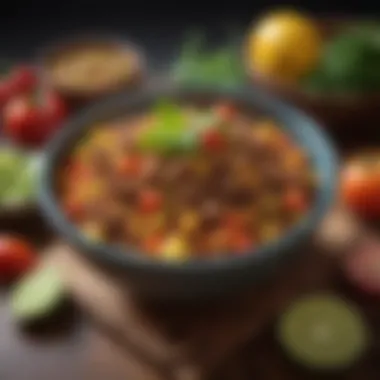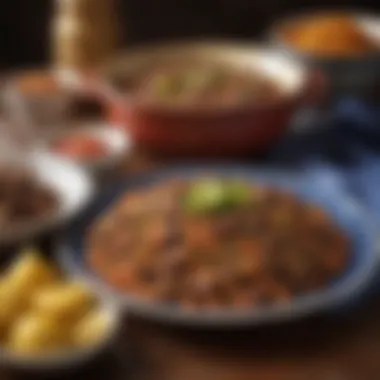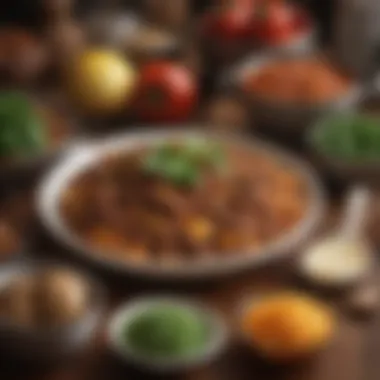Exploring Picadillo: A Culinary Tradition Worth Discovering


Intro
Picadillo is more than just a dish; it is a cultural symbol found in many Latin American households. This meal serves as a connection between generations, showcasing unique elements of regional traditions. The heritage of Picadillo, with its varying components and flavors, reflects the diverse histories and identities of the countries it graces.
In this article, we will delve into the specifics of Picadillo. From understanding its rich history to discussing its nutritional aspects, we aim to provide an informative view of this iconic dish. Additionally, preparation tips will assist both novice and experienced cooks in recreating Picadillo in their own kitchens. The analysis includes insights drawn from its portrayal in The New York Times, highlighting its significance in contemporary culinary discussions.
Let us begin by exploring the foundational elements of Picadillo, starting with a clear overview of the dish itself.
Prologue to Picadillo
Picadillo is more than just a dish; it’s a reflection of cultural identity, family tradition, and culinary adaptability. This introduction sets the stage for understanding why Picadillo is valued across different Latin American cultures. By exploring its roots and contemporary interpretations, readers will begin to grasp the importance of this dish in celebrations and daily life.
Understanding Picadillo
Picadillo is a seasoned ground meat dish, often made with beef, though variations exist with pork or chicken. It usually incorporates a blend of vegetables like onions, bell peppers, and tomatoes. The richness often comes from spices and herbs that vary by region. Commonly, olives and raisins add a unique sweetness and depth, resulting in a comforting yet multifaceted flavor profile. This dish serves not only as a meal but also as a canvas for personal preference, reflecting local ingredients and tastes.
Cultural Significance
The cultural relevance of Picadillo cannot be understated. It symbolizes home and togetherness, often prepared for family gatherings, holidays, and festive occasions. Different nations, such as Cuba, Mexico, and the Dominican Republic, inject their unique spin, making it a versatile staple.
"Picadillo tells a story—it narrates the historical journey of migrants and their culinary exchanges."
In Cuba, for example, it is often accompanied by rice and black beans, making a hearty meal that invokes a sense of nostalgia. In Mexico, spices may dominate the flavor profile, showcasing the influence of indigenous cooking techniques. Understanding these cultural narratives is crucial as it highlights the dish's role in community bonds and cultural expression.
Exploring Picadillo offers insights into family heritage, regional ingredients, and the significance of food in uniting people.
The Roots of Picadillo
Understanding the roots of Picadillo is essential for grasping its significance across various cultures. This dish reflects the historical, social, and culinary evolutions within the regions where it has thrived. The combination of ingredients and cooking techniques showcases a melding of traditions, giving rise to a complex tapestry of flavors and stories.
Historical Context
Picadillo's origins can be traced back to Spain, where it began as a frugal dish, made from leftover meat combined with rice and vegetables. The dish crossed the Atlantic during the colonial times, leading to its adaptation in Latin America and the Caribbean. It became popular among various classes, from the wealthy to the working classes, due to the versatility and affordable nature of its ingredients. Over time, Picadillo evolved, absorbing local flavors and practices, resulting in numerous interpretations. This historical journey emphasizes how culinary practices evolve by geography and context.
Regional Variations
Latin America
In Latin America, Picadillo stands as a culinary symbol, found in each nation with a unique signature. For example, Mexican Picadillo often incorporates ingredients like potatoes and olives, offering a different taste profile compared to its counterparts. The key characteristic of Latin American Picadillo is its adaptability. This versatility makes it a popular choice for families who want an affordable yet hearty meal. Moreover, the use of local spices and herbs varies significantly, resulting in diverse and rich flavors that can cater to various palates.
Unique features in Latin American variations include:
- Use of fresh local produce, such as bell peppers and tomatoes.
- Inclusion of unique spices native to the region, enhancing flavor.
However, some may argue that an overemphasis on customization can overshadow traditional recipes that define the essence of the dish.
Spain
Spain's contribution is notable with its rich culinary history. In Spain, Picadillo features a classic combination of ground beef, onions, and spices. The distinctive sweet and savory balance comes from the addition of raisins or almonds. This uniqueness makes Spanish Picadillo not only flavorful but also a memorable experience.
One key aspect is how Spanish Picadillo often serves as a tapa, promoting sharing and socializing. This cultural characteristic resonates with the Spanish dining tradition, making it an ideal choice for gatherings. The unique feature of Spanish Picadillo juxtaposes sweet and savory ingredients, which can be a delightful surprise for those experiencing it for the first time.
Some critics suggest that the dish’s complexity might lead to confusion over its original intent, yet the blend of flavors remains appealing to many.
Caribbean
The Caribbean adaptation of Picadillo reflects a unique set of influences, often infused with island flavors including spices, citrus, and tropical vegetables. For example, the Cuban version, or "picadillo a la habanera," includes green olives and capers, adding briny notes. The Caribbean Picadillo is characterized by its emphasis on bold flavors, which is beneficial for enhancing the overall dining experience.
Unique features in Caribbean Picadillo include:


- Heavy use of spices such as cumin and oregano.
- Incorporation of tropical fruits like plantains that can add sweetness.
However, the strong flavor profiles may not suit everyone's preferences, leading to divided opinions on what is considered "traditional" compared to modern interpretations.
Understanding these roots helps in appreciating how Picadillo is more than just a dish; it is a narrative of history, culture, and the culinary journey.
Picadillo Ingredients
Understanding the ingredients used in Picadillo is vital to appreciating this dish’s versatility and depth. This culinary staple relies on a foundation of quality components that contribute not only to its flavor but also its cultural significance. The selection of ingredients shapes the nuances of the dish and allows for creativity in preparation.
Traditional Ingredients
In its traditional form, Picadillo often features several key ingredients that create its signature taste. Ground beef serves as the main protein source, melding perfectly with spices like cumin, bay leaves, and black pepper. Alongside these spices, onions, garlic, and bell peppers provide aromatic depth. Tomatoes, either fresh or canned, add acidity and moisture, bringing the dish together.
Another notable ingredient is olives, which lend a briny contrast to the richness of the meat. Raisins or other dried fruits are sometimes included, offering a hint of sweetness. The combination of these ingredients defines the flavor profile of Picadillo, making it both comforting and satisfying.
Variations and Alternatives
Picadillo is adaptable, allowing cooks to modify ingredients based on personal preference or available resources.
Meat Options
While ground beef is common, other meats can be used for variety. Ground pork or chicken can serve as substitutes, adding unique flavors. Some regions also use a mix of meats, which can enhance the dish's richness.
Using different meats allows for flexibility. Each choice can influence the final taste and texture. For example, ground turkey provides a leaner option but can be less flavorful if not seasoned well. Choosing the right meat can have a significant impact on the overall dish, especially considering texture and moisture.
Vegetarian Alternatives
For those who prefer meatless options, vegetarian Picadillo is increasingly popular. Substitutes like lentils or mushrooms can replicate the texture of ground meat while adding nutritional benefits. Lentils are particularly well-suited, offering protein and fiber, along with a hearty consistency.
Mushrooms add an earthy flavor and can absorb seasonings effectively. This flexibility supports a plant-based lifestyle without sacrificing flavor, making it easier for more people to enjoy the essence of Picadillo.
Regional Additions
Picadillo varies by region, with certain areas incorporating local ingredients that reflect their culinary traditions. In Cuba, for example, the use of capers and almonds is common, while Mexican versions may incorporate ingredients like potatoes and corn.
These regional ingredients create distinctive interpretations of Picadillo. The ability to adapt traditional recipes increases accessibility, encouraging home cooks to experiment with flavors specific to their culture. This not only preserves diversity but also fosters an appreciation for global cuisines.
"The beauty of Picadillo lies in its adaptability, transcending borders and inviting personal touch in every home."
Ultimately, understanding the myriad of ingredients used in Picadillo enriches the cooking experience. Whether sticking to traditional elements or innovating with alternatives, recognizing these choices contributes to a more profound connection with this enduring dish.
The New York Times Perspective
The New York Times has a significant influence on food journalism and culinary trends. Its articles often serve as a bridge between traditional recipes and contemporary cooking techniques. This balance is essential when looking at a dish like Picadillo, which embodies cultural heritage while evolving with modern tastes. Featuring recipes in such a prominent publication not only validates their cultural importance but also encourages broader acceptance and exploration among diverse audiences.
When the New York Times covers a dish like Picadillo, it does more than offer a recipe; it brings attention to the rich history and varied regional interpretations of the dish. This fosters a deeper appreciation for the culinary arts and promotes understanding of how ingredients and techniques differ from one culture to another. Recipes published in this esteemed newspaper become part of a conversation that can elevate home cooking to a valued art form.
Featured Recipes
The New York Times showcases a variety of Picadillo recipes that reflect regional differences and personal interpretations. Here are a few notable examples:
- Cuban Picadillo - This recipe typically uses ground beef and integrates olives, capers, and raisins, providing a sweet and savory experience.
- Mexican Picadillo - This version often incorporates diced potatoes and carrots, making it more hearty and comforting.
- Vegetarian Picadillo - A modern twist that utilizes lentils or plant-based proteins, catering to those who prefer meatless options.
These recipes often attract attention with their diverse flavor profiles, showcasing how Picadillo can adapt while remaining true to its roots.
Food Journalism and Cultural Representation
Food journalism is a significant vehicle for cultural exchange. The New York Times serves as a prominent platform for discussing the nuances of cuisine like Picadillo. By presenting it in detailed articles, readers gain insight into the social and cultural aspects surrounding this dish. This representation is critical, as it helps break down stereotypes and fosters a genuine understanding of culinary practices.


Moreover, the approach of food journalism should always be inclusive, allowing diverse voices to share their stories about Picadillo. This encourages respect for the dish and recognizes the collective heritage it embodies. The inclusion of various perspectives not only enriches the narrative surrounding Picadillo but also validates the experiences of those who cherish it.
Cooking Techniques for Picadillo
Cooking techniques are crucial for creating a delicious Picadillo. The right methods influence texture, flavor, and overall satisfaction of the dish. Both novice and experienced cooks benefit from understanding these techniques. Good cooking assures that flavors marry well and the dish remains true to its roots while adapting to personal tastes. In this section, we will delve into critical preparation techniques and avoid common mistakes.
Preparation Techniques
Chopping and Sautéing
Chopping is foundational in the preparation of Picadillo. It ensures that all ingredients are uniform, enhancing even cooking. Sautéing follows as it allows for the development of rich flavors. The key characteristic of this technique is its ability to quickly soften aromatics like onions and peppers while retaining their inherent flavors. Sautéing is a popular choice due to its speed and effectiveness.
Unique features of chopping and sautéing include:
- Flavor Development: Caramelization occurs, adding depth to the dish.
- Moisture Control: Sautéing can help reduce excess moisture from vegetables.
There are advantages and disadvantages to consider. While sautéing is quick, overcooking can lead to bitterness. Moreover, balancing heat is crucial to prevent burning.
Simmering and Braising
Simmering and braising are techniques that enrich the flavors of Picadillo. Simmering involves cooking at low heat, allowing ingredients to blend perfectly. It is particularly valuable after initial sautéing. The key characteristic is the gentle heat that melds flavors without losing moisture. This makes it a reliable choice for cooking meat until tender.
Unique characteristics of simmering and braising include:
- Flavor Integration: Ingredients combine, creating a harmonious profile.
- Tenderization: Slow cooking breaks down tough fibers in meat.
The benefits of these techniques are clear. They infuse the dish with a deep, rich taste, and produce a satisfying texture. However, they require time and attention to detail, as over-simmering may lead to loss of flavor integrity.
Common Mistakes to Avoid
Cooking Picadillo comes with its pitfalls. Avoiding these common mistakes ensures the dish’s success:
- Neglecting Meat Quality: Always choose fresh, high-quality meat. Lower quality can ruin the dish.
- Overcrowding the Pan: When sautéing, overcrowding can cause steaming instead of browning. Cook in batches if necessary.
- Skipping the Seasoning: Picadillo relies on proper seasoning. Underseasoning can lead to bland flavors, while overseasoning can make the dish overwhelming.
- Inadequate Cooking Time: Rushing through cooking can result in tough meat and unbalanced flavors.
Serving Suggestions
Serving suggestions play a crucial role in enhancing the overall experience of enjoying picadillo. This dish, rich in flavors and textures, becomes even more delightful when accompanied by well-chosen side dishes. These selections not only complement the main dish but also contribute to a balanced meal. Moreover, serving picadillo with the right sides can elevate its cultural significance and allow for a more authentic dining experience.
Complementary Side Dishes
Rice
Rice serves as a staple side dish across many cultures, and its pairing with picadillo is no exception. The key characteristic of rice is its ability to absorb flavors, making it a suitable companion for the robust flavors of picadillo. It acts as a neutral canvas that offsets the dish’s spices and richness. American long-grain rice, for instance, is a popular choice due to its fluffy texture. Its unique feature is how it complements the juiciness of the meat and other ingredients without overwhelming them.
However, using white rice may have its disadvantages in terms of nutritional value when compared to whole grain options. For a more health-conscious approach, brown rice might be a better selection, providing fiber and nutrients that can be beneficial for overall health.
Plantains
Plantains add a distinct sweetness that contrasts beautifully with the savory flavors of picadillo. Their unique feature is their versatility—when fried or baked, they bring a tender texture that enhances each bite. Fried plantains also provide a crispy texture that adds a rich element to the meal.
Despite their popularity, one must consider that fried plantains are calorie-dense and may not suit all dietary preferences. Nonetheless, they remain a beloved choice, offering an appealing balance to the hearty nature of picadillo.
Salad
A fresh salad can lighten the meal, making it an excellent choice for serving with picadillo. The main aspect of a salad is its refreshing qualities, which can cleanse the palate between bites. A simple green salad, perhaps with tomatoes and avocado, introduces a vibrant contrast in both taste and appearance.
The advantage of a salad is its ability to be tailored to personal tastes and dietary requirements. However, it might lack the heartiness that some diners desire when serving picadillo. Nevertheless, it contributes significantly to creating a well-rounded dining experience.
Presentation Tips


Preventing the meal from looking monotonous is essential. A colorful plate enhances presentation. Consider arranging the rice next to the picadillo, with plantains stacked artistically on the other side. Drizzle a light dressing over the salad to add a glisten. Using garnishes like cilantro or lime wedges can also provide visual appeal. These simple yet effective presentation techniques can elevate the dining experience and make it more enjoyable.
Nutritional Aspects of Picadillo
Understanding the nutritional aspects of Picadillo is crucial for appreciating its role in diverse cuisines. This dish, rich in flavors and textures, also brings several nutritional advantages. It provides essential ingredients that contribute to a balanced diet, depending on the variations you choose. This section offers insight into the nutritional value of Picadillo and health considerations related to its preparation and ingredients.
Nutritional Value
Picadillo typically consists of ground meat, vegetables, spices, and sometimes legumes. \nThis combination results in a dish that can be quite nutritionally dense. The ground beef or pork provides protein, which is vital for muscle repair and overall health. Additionally, the vegetables like onions and bell peppers add vitamins, fiber, and minerals. For instance, bell peppers are rich in vitamin C, while onions can aid in heart health and digestion.
A standard serving can also include carbohydrates, especially if served with rice or potatoes. This makes it a complete meal. It's important to be mindful of portion sizes, as the overall caloric intake can vary based on how the dish is prepared and the ingredients used.
Health Considerations
Healthier Cooking Methods
Opting for healthier cooking methods is essential when preparing Picadillo. Instead of frying the meat, consider baking or steaming. These methods retain more nutrients and reduce the amount of added fat. Cooking methods like simmering can also enhance flavors without requiring additional oils. Moreover, using a non-stick pan minimizes the necessity for oils while allowing for a well-cooked dish.
These healthier cooking methods ensure that Picadillo maintains its taste while fitting into a balanced diet. The choice to incorporate lean meats, such as chicken or turkey, can significantly reduce saturated fat content.
Ingredient Substitutions
Ingredient substitutions can greatly enhance the nutritional profile of Picadillo. For example, substituting ground beef with leaner options like ground turkey or plant-based meat can lower calories and saturated fats. Additionally, incorporating legumes like lentils or black beans not only boosts fiber content but also introduces plant-based protein.
This flexibility in ingredients makes Picadillo a versatile dish suitable for different dietary needs. One can easily modify recipes to accommodate vegetarian or gluten-free diets. However, while these modifications can enhance nutritional value, they may also alter the traditional flavor profile that many have come to expect from Picadillo.
Picadillo in Popular Culture
Picadillo stands not only as a beloved dish within numerous households across Latin America, but also as a symbol of cultural identity. Its presence in popular culture amplifies its significance as a staple dish that reflects the diverse culinary traditions from which it originates. Exploring its presence in pop culture reveals how food transcends beyond mere sustenance, showcasing the nuances of identity, community, and tradition. This section examines how Picadillo has made a mark in both media and social spaces, influencing the way people perceive and experience this dish.
Pop Culture References
Throughout film and television, Picadillo has appeared as a representation of home and familial ties. It often symbolizes comfort during pivotal moments or family gatherings. Not only does it serve as a backdrop for storytelling, but it also emphasizes the importance of culinary practices in preserving cultural heritage.
Some notable references include:
- Movies: In films like "Chef," dishes including Picadillo are portrayed as heartfelt connections to one's roots. The act of cooking is not just a matter of preparing food, but a way of sharing love and memories.
- Television Shows: Various cooking shows often highlight Picadillo recipes, showcasing techniques and variations that span regions from Spain to the Caribbean. These programs help popularize the dish, making it accessible to both seasoned cooks and novices.
These references further instill a sense of cultural pride and encourage viewers to explore traditional recipes in their own kitchens.
Social Media Trends
In the digital age, social media platforms have played a significant role in revitalizing and reshaping the perception of Picadillo. Food bloggers and Instagram influencers showcase diverse takes on this classic dish, adapting recipes to cater to modern tastes while maintaining its essence. The hashtag #Picadillo has gathered traction, allowing food enthusiasts to share their versions, thus creating a community around this cherished meal.
Some trends include:
- Visual Storytelling: Beautifully plated Picadillo dishes flood social media, inviting attention and inspiring creativity. The aesthetic appeal fosters engagement and often sparks discussions regarding techniques and ingredient choices.
- User-Generated Content: Influencers encourage followers to recreate family recipes and share their culinary stories, generating a sense of togetherness in food exploration.
- Cultural Exchange: Posts featuring Picadillo can lead to conversations about its origins and variations, furthering appreciation and understanding of Latin American cuisines.
Overall, Picadillo's presence in popular culture transforms it into more than a simple dish. It becomes a narrative thread that ties individuals to their heritage, while also inviting new generations to participate in a culinary tradition that continues to evolve.
Culmination
Picadillo has a unique place in culinary discussions, particularly within Latin American culture. This article has highlighted the historical, cultural, and nutritional aspects of the dish. It's essential to recognize how these elements contribute to its enduring appeal.
The Enduring Appeal of Picadillo
Picadillo captivates food lovers for various reasons. One major element is its versatility. Each region offers a distinct twist, making it an inviting dish for diverse palates. This adaptability is more than just a culinary feature; it also embodies the spirit of community and family gatherings. During celebrations or everyday dinners, Picadillo can bring people together, creating a shared experience around the table.
Furthermore, the nutritional content enhances its attractiveness. With proper ingredient choices, Picadillo can be a balanced option, catering to both traditional and modern dietary preferences. Ingredients like lean meats or plant-based alternatives help in crafting healthier versions without compromising flavor.
Encouragement to Explore
The journey of discovering Picadillo does not have to stop here. Rather, it invites food enthusiasts to experiment. Consider using ingredients commonly found in your region or trying specific techniques to customize your version. Exploring Picadillo in its various forms allows you to appreciate its rich history and cultural significance.
In addition, seeking out recipes from specific regions can deepen your understanding of this dish. For example, look into Cuban, Mexican, or Spanish adaptations. This exploration will not only enhance your culinary skills but also provide insight into the unique histories tied to the dish.
"The enjoyment of food is multiplied when shared with others. Picadillo’s communal nature is a perfect example of this principle."







